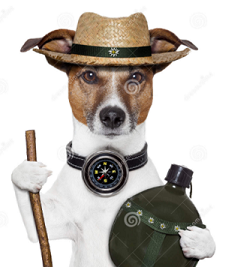Welcome back to Science Sunday We've all heard stories of dogs finding their way home, sometimes from hundreds of kilometres (click here to read some). But how do they do it? Many animals and even insects have been shown to be able to navigate with the help of the earth's magnetic field, an ability known as magnetoreception. What seems like a rather odd study in 2013, published in Frontiers in Zoology, researchers tried to prove that dogs have this ability by recording their alignment when they were pooping or peeing or just marking territory. They measured the direction of the body axis in 70 dogs of 37 breeds during defecation (1,893 observations) and urination (5,582 observations) over a two-year period. They were able to conclude from this data that dogs preferred to excrete with the body being aligned along the North–South axis under calm magnetic field conditions. (the correlation was extinguished when the magnetic field was unstable). Beyond mapping where your dog poops, this study did establish that dogs are capable of magnetoreception. The actual mechanism of magnetoreception in dogs was discovered in a 2016 study. Cryptochromes are a protein involved in the circadian rhythms of plants and animals, and possibly also in the sensing of magnetic fields in a number of species. Cryptochrome 1a is located in photoreceptors in birds' eyes and is activated by the magnetic field. Researchers from the Max Planck Institute for Brain Research in Frankfurt have detected cryptochrome 1a in photoreceptors in several mammalian species including dogs. In a further test in 2018 to prove that dogs have this ability, dogs were trained to locate a simple bar magnet. After removing confounding factors of site and smell, 13 of 16 dogs were able to locate a magnet with no other clues than the magnetic field. Finally a new study released earlier this month used hunting dogs to find out if they are using their magnetorecption capability to find their way back to their owners after a hunting run. Between September 2014 and December 2017, the study team equipped 27 hunting dogs of 10 different breeds, with GPS trackers. These dogs were allowed to roam in forested areas away from buildings, roads and powerlines. Dogs ran individually and returned on their own. Trips took between 30 and 90 minutes. Owners hid close to the location where the dog was released. The GPS data, from a total of 622 excursions in 62 different locations in the Czech Republic, were then compiled and analyzed. Most of the dogs simply followed their own scent back, a method know as tracking. However in 233 cases, the dogs took a novel route back, a method known as scouting. Interestingly, the scouting dogs began their trip back with a run in the north/south direction, regardless of the direction of the trip. This "compass run" was surmised to be instrumental in orienting the dogs to the magnetic field and the direction home. The scouting dogs returned faster to their owners than the dogs using the tracking method, in which they just came back the same way they went out. So looks like not only will Lassie find her way home by herself, she will also poop in the north/south direction while doing it.
0 Comments
Leave a Reply. |
|
PHONE US AT 705-652-0682
|
Other enterprises under the DueNorth Brand: DueNorth Pet Care for excellent dog Boarding, Duenorth Flatcoated Retrievers for beautiful flatcoats
 RSS Feed
RSS Feed